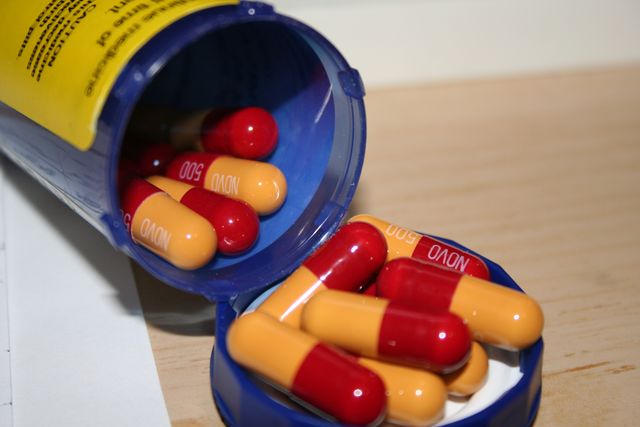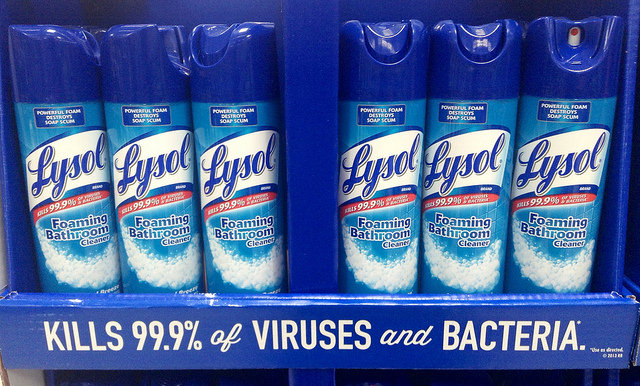Difference between Antibiotic and Antibacterial

What is Antibiotic?
Definition and production:
An antibiotic is defined as any chemical substance that is able to kill bacteria, fungi and parasites, and can thus be used against prokaryote and eukaryote organisms. Antibiotics can be produced by living organisms in a natural environment, and synthetically produced and used as medicine. In fact most antibiotics have been discovered by observation of natural organisms fighting off bacteria. Sometimes this has been accidental, for example, Alexander Fleming discovered the antibiotic penicillin by noting that the mold growing on his bacterial culture was killing the bacteria.
Classification of Antibiotics:
Antibiotics can be classified based on which organisms they kill:
- Antibacterials kill bacteria
- Antifungals kill fungi
- Antiparasitics kill parasites
Although they can be classified in this way there are antibiotics that can act both as antibacterials and antiparasitics. An example is metronidazole, which kills the bacterium Helicobacter pylori and the protozoan parasite Giardia.
Parts of cell targeted
Antibiotics can target the peptidoglycan cell wall of bacteria or the chitin and glucan cell wall of fungi, DNA of bacteria and DNA of parasitic protozoa. In antibiotics that also target protozoa, the side effects can be severe because protozoa have eukaryotic cells similar to ours.
Dangers of antibiotic misuse/overuse:
Since antibiotics kill so many organisms, including beneficial bacteria, they can upset the natural balance in the human body. The result is that this can allow other harmful bacteria to thrive. For example, Clostridium difficile which can grow in excess after antibiotic use. C. difficile causes a dangerous gastrointestinal condition. This is why people are encouraged to take probiotics while on antibiotics.
The other problem can occur if you do not take the entire course of antibiotics. This can lead to future antibiotic resistance since the remaining bacteria that are resistant are the cells left behind to reproduce. The antibiotic thus selects for the resistant organisms. This has become a major problem, e.g. Methicillin -resistant Staphylococcus aureus, which can be deadly.

What is Antibacterial?
Definition and production:
An antibacterial is a chemical substance that specifically kills bacterial cells. These substances are thus only effective against prokaryotic organisms that have the features typical of a bacterial cell. An antibiotic that is produced to only kill bacteria only has antibacterial properties. While the term antibacterial can refer to an antibiotic in everyday use it refers more often today to antibacterial soaps and disinfectant products that have been produced. Antibacterials can be produced synthetically as well as from living organisms.
Classification of Antibacterial
Antibacterials can be classified in different ways. One way they can be classified is based on mode of action. The two types based on how they act:
- Bacteriocidal –these are antibacterials which completely kill and destroy bacterial cells.
- Bacteriostatic – these are antibacterials which inhibit the growth and reproduction of bacterial cells.
Antibacterials can also be classified based on whether or not they leave a residue.
Parts of cell targeted
An antibacterial targets a specific feature of bacteria such as the peptidoglycan cell wall, bacterial DNA or some aspect of metabolism that is unique to bacteria. Since antibacterials only target bacteria they are less harmful to humans and have fewer side effects than antiparasitic or antifungal antibiotics. This is because bacteria are prokaryotic cells which are very different from our cells, unlike fungi and parasites which have eukaryotic cells similar to ours.
Dangers of antibacterial misuse/overuse
Antibacterial overuse in the form of excessive washing with hand sanitizers may lead to problems for children who may become more prone to allergies later in life. This is because children need to be exposed to microbes in order to develop a healthy immune system.
Antibacterial products in some cases leave a residue that kills all but the strongest bacteria. This means that more harmful bacteria are selected for resulting in bacterial resistance. Research with triclosan, a common ingredient in antibacterial sanitizers has shown a tendency for bacteria to develop resistance against the antibiotic isoniazid which is used to treat tuberculosis.
Difference between Antibiotic and Antibacterial
-
Target organism involved in Antibiotic and Antibacterial
Antibiotic refers to any chemical substance that targets and kills bacteria, fungi or parasites. Antibacterial refers to a chemical substance that is specifically designed to only target and kill bacteria.
-
Cell type targeted in Antibiotic and Antibacterial
Antibiotics can target both eukaryotic and prokaryotic cells while an antibacterial can only target a prokaryotic cell.
-
Cell sites targeted in Antibiotic and Antibacterial
Antibacterials by definition only kill bacteria and thus only target the peptidoglycan cell wall, bacterial DNA and metabolism, while antibiotics may also target chitin and glucan fungal cell walls and DNA of parasites.
-
Everyday vernacular of Antibiotic and Antibacterial
In everyday use, the term antibiotics is used to refer to medicines that are taken as capsules, tablets or through an intravenous line, while the term antibacterials refers to substances that are used as ointments, soaps or disinfectants.
-
Side effects of Antibiotic and Antibacterial
Antibacterials are less harmful to people than antibiotics that can also kill parasites or those that kill fungi, because bacterial cells are very different to human cells.
Table comparing Antibiotic and Antibacterial

Summary of Antibiotic Vs. Antibacterial
- Antibiotics and antibacterials both kill bacteria but antibiotics can sometimes also kill fungi and parasites such as protozoa.
- Antibacterials only target features of prokaryotic bacterial cells, such as the peptidoglycan cell wall and DNA and metabolism unique to these cells.
- Antibiotics can target fungal cell walls and the DNA of parasites as well as bacterial features.
- In everyday language antibiotic is used to refer to medicine taken internally while antibacterial is used to refer to soaps and disinfectants.
- Difference Between Rumination and Regurgitation - June 13, 2024
- Difference Between Pyelectasis and Hydronephrosis - June 4, 2024
- Difference Between Cellulitis and Erysipelas - June 1, 2024
Search DifferenceBetween.net :
1 Comment
Leave a Response
References :
[0]Image credit: https://commons.wikimedia.org/wiki/File:NOVAMOXIN_antibiotic.jpg#/media/File:NOVAMOXIN_antibiotic.jpg
[1]Image credit: https://www.flickr.com/photos/jeepersmedia/14391198089
[2]Debono, Manuel, and Robert S. Gordee. "Antibiotics that inhibit fungal cell wall development." Annual Reviews in Microbiology 48.1 (1994): 471-497.
[3]Mobley, H. "How do antibiotics kill bacterial cells but not human cells?" Scientific American 294.6 (2006): 98-98.
[4]Samuelson, John. "Why metronidazole is active against both bacteria and parasites." Antimicrobial agents and chemotherapy 43.7 (1999): 1533-1541.

Bravo, I like the way you potraited.Besides this why dont you explaine about antifungals.I can see some kind of relation between microplastic and antifungals